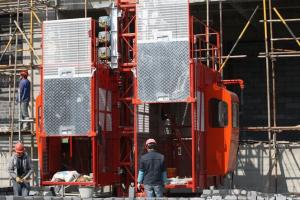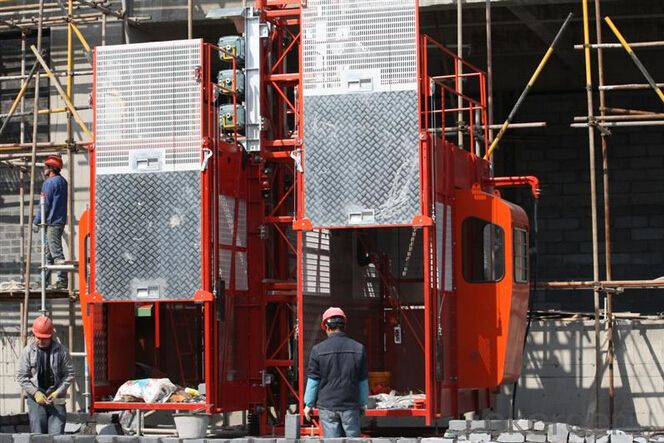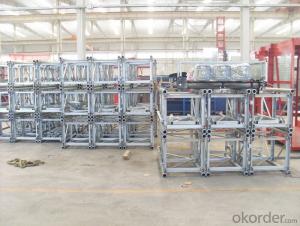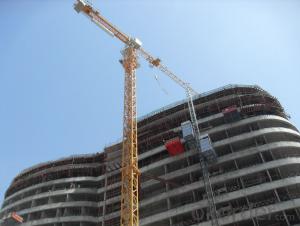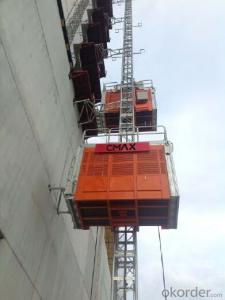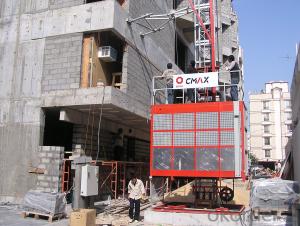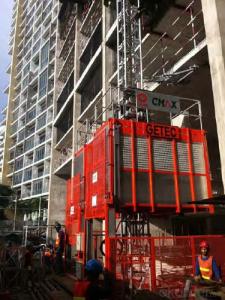SC100/100 Building Material Hoist with CE Certificate
- Loading Port:
- China main port
- Payment Terms:
- TT OR LC
- Min Order Qty:
- 1 pc
- Supply Capability:
- 1000 pc/month
OKorder Service Pledge
OKorder Financial Service
You Might Also Like
Structure of Building Hoist:
1. It is equipped with fully safety devices to guarantee the safe working;
2. Stable running and comfortable adaptability;
3. The transmission system adopts two-drive motors and three-drive motors. Planar double-eveloping worm gear reducer is adopted ensuring the high efficiency, max payload and long service life;
4. Simple electrical control system, easy operation and convenient maintenance withlow failure rate.
Advantages of Building hoist
Our advantage:
1- More than 130,000 employee.
2- state-owned company and Fortune 500 enterprises.
3- own systems of production engineering.
4- 10 service branch in the work, such as UAE. KSA. IRAN, USA. INDIA, RUSSIA...
5- Professional construction equipment supplier.
6- technical experts with great experience in the sector.
7- More pls visit our factory, you will find we are your best choice.
Hoist Advantages:
1. Quality raw material, strict production management and career responsibility to make the hoist with the highest safety control, and the advanced design make it with good vision to enhance the safety.
2. Simple structure and low cost
3. Convenient in installation, disassembly and maintenance.
4. Energy-saving, starting current is lower than the rated current.
5. Adjustable speed, the maximum speed could reach 96m/min.
6. Frequency conversion control system, stable starting and breaking and low mechanical wear .
Building Hoist Images:
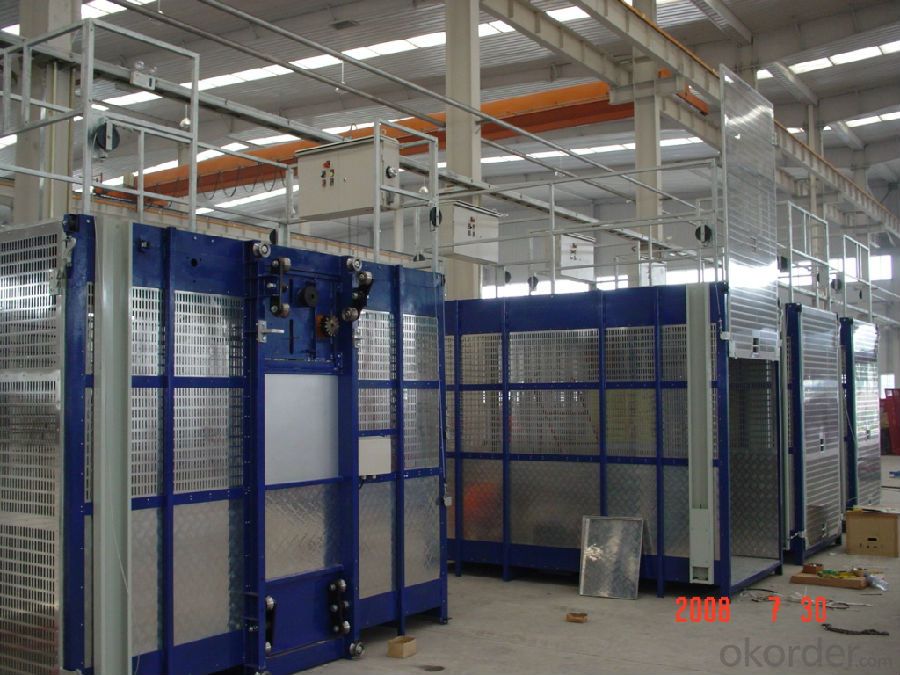
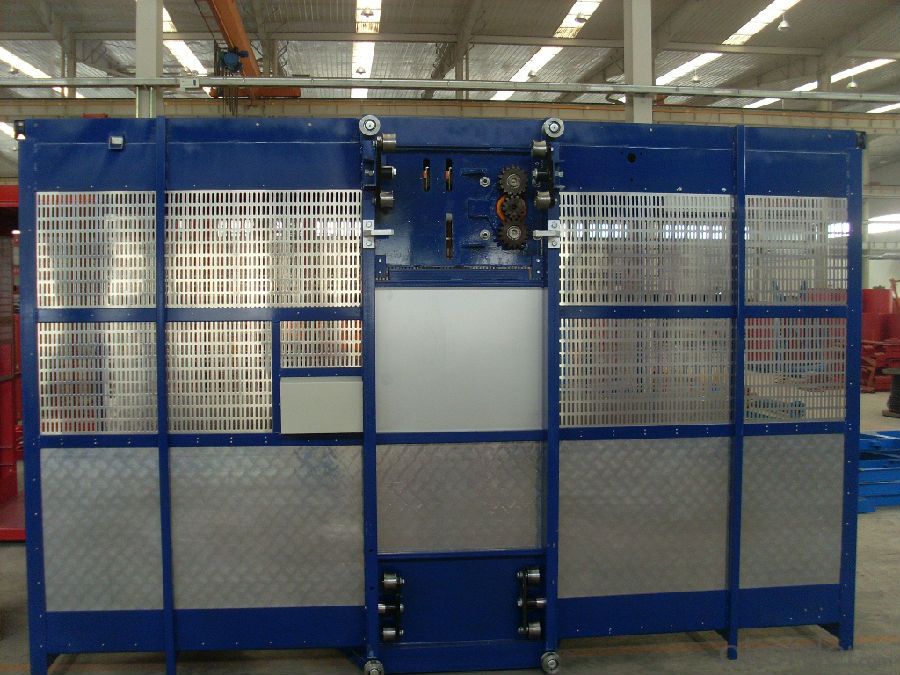
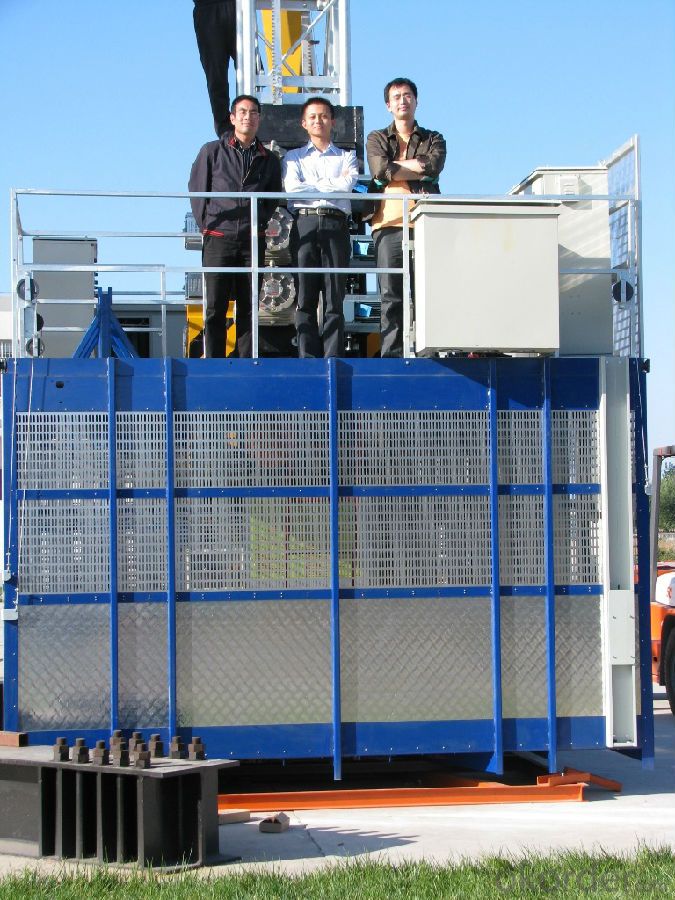
Building hoist Specifiction:
| Model(single and double cage) | Capacity(kgs) | Lifting speed(m/min) | Motor power(kw) |
| SC100TD | 1000 | 36 | 2x11 |
| SC200TD | 2000 | 36 | 3x11 |
| SC270TD | 2700 | 36 | 3x15 |
| SC320TD | 3200 | 36 | 3x18.5 |
| SC100/100TD | 2x1000 | 36 | 2x2x11 |
| SC200/200TD | 2x2000 | 36 | 2x3x11 |
| SC270/270TD | 2x2700 | 36 | 2x3x15 |
| SC320/320TD | 2x3200 | 36 | 2x3x18.5 |
| SC100GZ | 1000 | 0-63 | 2x15 |
| SC200GZ | 2000 | 0-63 | 3x18.5 |
| SC270GZ | 2700 | 0-63 | 3x22 |
| SC200/200GZ | 2x2000 | 0-63 | 2x3x15 |
| SC270/270GZ | 2x2700 | 0-63 | 2x3x18.5 |
| SC320/320GZ | 2x3200 | 0-63 | 2x3x22 |
| SC100/100G | 2x1000 | 0-96 | 2x2x22 |
| SC200/200G | 2x2000 | 0-96 | 2x2x22 |
| SC270/270G | 2x2700 | 0-96 | 2x2x22 |
FAQ of Building Hoist:
Q: What is the building hoist main purpose?
A: Building hoist equipped with double or single cabin to transport the materials and labors up and down. It's the ideal
construction equipment for vertical transportation in the field of construction.
Q: What is the main structure of building hoist?
A: The P/M construction hoist mainly contains metal structure, driving system, electrical control system, cable guide &
protection system, electrical top crane and safety device.
Q: What is the meaning of the building hoist’s code?
A: Take SC200/200 for example: “SC” stands for rack and pinion hoist, “200/200” stands for double cage and capacity
is 2 tons per cage. “SC200” stands for single cage and capacity is 2 tons.
Q: What is the dimension of the cage?
A: Normally the cage dimension is 3X1.5X2.5M (L/W/H) for 2t type hoist. Details should be checked according to our
quotation sheet. Also, the size can be customized according to the factual site condition. There are two doors (entrance
& exit doors) for each cage, It can be produced as up & down sliding or ramping model for safety and convenience
- Q: What is the function or use of constructing a building hoist?
- <p>The purpose of building hoists is to facilitate the vertical transportation of materials, equipment, and sometimes personnel during the construction process. They are essential for moving heavy items to various floors or levels of a building under construction. Hoists enhance efficiency, reduce manual labor, and improve safety by minimizing the risk of accidents associated with manual handling of heavy loads. They are particularly crucial in high-rise construction where access is limited and the volume of materials to be moved is substantial.</p>
- Q: Is it possible to use a building hoist to lift multiple items simultaneously?
- <p>Yes, a building hoist can be used for lifting multiple objects at once, provided that the combined weight of the objects does not exceed the hoist's load capacity. It's important to ensure that the hoist is designed for such use and that safety precautions are strictly followed to prevent accidents. The objects should be secured properly to avoid any shifting during the lift, and the operation should be conducted by trained personnel to maintain safety standards.</p>
- Q: Is it possible to substitute an automatic lifting device with a manual one in construction projects?
- <p>While it is technically possible to use a manual lifting device in place of an automatic one for certain construction tasks, it is not generally recommended. Manual lifting devices are typically less efficient, slower, and can pose safety risks due to the physical effort required. They may also not meet the load-bearing requirements of heavy construction materials. Automatic lifting devices are designed for efficiency, safety, and to handle heavy loads, making them more suitable for construction work. It's crucial to adhere to safety standards and use appropriate equipment for the task at hand.</p>
- Q: This question asks for a description of the process of using an emergency stop button specifically in the context of a building hoist.
- <p>To use an emergency stop button on a building hoist, first, ensure you are familiar with the hoist's controls and safety features. Locate the emergency stop button, which is typically a red mushroom-shaped button or switch, prominently placed and easily accessible. In an emergency, press and hold the button firmly. This action will immediately stop all hoist functions, including movement and operation. After pressing the emergency stop, evacuate the area if necessary and notify the appropriate personnel to address the situation. Remember, the emergency stop should only be used in situations where immediate action is required to prevent harm or damage. Regular training and drills can help ensure you are prepared to use the emergency stop button correctly and effectively.</p>
- Q: This question asks for a description of the process of operating a building hoist using a remote control system.
- <p>To use a remote control system for a building hoist, first ensure that the hoist is properly installed and inspected for safety. Turn on the hoist's power supply and ensure the remote control is synced with the hoist. Familiarize yourself with the control panel, which typically includes buttons for up, down, stop, and emergency stop. Operate the hoist by pressing the up or down buttons to lift or lower the load. Always monitor the load's movement and communicate with workers on site. Use the stop button to halt the hoist if needed, and the emergency stop button in case of an immediate hazard. Regularly check the hoist's operation and maintain the remote control system to ensure smooth and safe operation.</p>
- Q: How many kw is the sc construction elevator
- The construction elevator sc200/200 is rated at 63 kw power, and the power consumption is greater.
- Q: This question asks for the method to determine the maximum weight a building hoist can lift.
- <p>The lifting capacity of a building hoist is calculated by considering several factors including the hoist's motor power, the strength of the hoist's construction materials, and the safety factor. The manufacturer usually provides the maximum lifting capacity based on these factors. To calculate it manually, you would need to know the motor's lifting force, the efficiency of the hoist's mechanical system, and apply a safety factor to ensure the hoist operates within safe limits. It's important to follow the manufacturer's guidelines and never exceed the specified lifting capacity to prevent accidents and ensure the hoist's longevity.</p>
- Q: What is the safety device for construction elevator?
- Safety guard, safety hook, safety switch (limit switch, limit switch, break cord switch), braking system, overload protection device etc.
- Q: Is it possible to use a lifting device to lift objects that are heavier than its specified maximum load?
- <p>No, a lifting device should never be used to lift objects that exceed its rated load capacity. Doing so can lead to catastrophic failure of the device, potentially causing serious injury or death. Always adhere to the manufacturer's specifications to ensure safety and prevent accidents. Overloading a lifting device can result in structural damage, compromised safety mechanisms, and increased risk of collapse or dropping the load. It is crucial to respect the load limits to maintain the integrity and reliability of the lifting equipment.</p>
- Q: What precautions should be taken when using manual lifting equipment to ensure safety?
- <p>Safety measures for using manual lifting devices include inspecting equipment for damage before use, ensuring the load is within the device's weight capacity, using proper lifting techniques, maintaining a clear path for lifting, and securing the load to prevent shifting. Always wear appropriate personal protective equipment, such as gloves and safety shoes. Never exceed the rated capacity of the lifting device, and avoid sudden or jerky movements that could cause loss of control. Regular maintenance and training on safe lifting practices are also crucial to prevent accidents.</p>
Send your message to us
SC100/100 Building Material Hoist with CE Certificate
- Loading Port:
- China main port
- Payment Terms:
- TT OR LC
- Min Order Qty:
- 1 pc
- Supply Capability:
- 1000 pc/month
OKorder Service Pledge
OKorder Financial Service
Similar products
Hot products
Hot Searches
Related keywords
